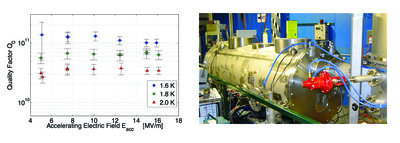CLASSE NEWS | 20 Jun 2013
 Intellectual Merit: Cornell has fabricated, installed, and tested a prototype superconducting RF cavity for the Energy Recovery Linac (ERL) that Cornell plans to build as a novel accelerator for x-ray science. For this test, the cavity was installed in an accelerator cryogenic module, fully equipped with all components needed for high beam current operation. The graph shows the quality factor Q0 (inverse proportional to the wall losses) of the prototype ERL cavity as function of accelerating field. The ERL specifications have been 2x1010 at 16MV/m. These have now been surpassed, reaching exceptionally high quality factors of up to 10x1010 for an operating temperature of 1.6K. This low loss operation (expressed as a high quality factor Q0) is a world record for an SRF cavity in a particle accelerator environment.
Broader Impacts: Energy costs drive the design of the next generation of particle accelerators used for research in medicine, industry, and scientific research. By utilizing microwave cavities made out of superconducting material to accelerate the particles, the energy use of particle accelerators can be reduced dramatically. Now the energy required to cool the superconducting cavities to cryogenic temperatures drives the energy budget. Cornell University has made an enormous step forward improving the performance of the superconducting accelerator cavities, slashing the energy losses to 1/6 of the current state-of-the-art. This new level of performance reduces the cooling costs so dramatically that other accelerator projects are reevaluating their assumptions and improving their designs.
Intellectual Merit: Cornell has fabricated, installed, and tested a prototype superconducting RF cavity for the Energy Recovery Linac (ERL) that Cornell plans to build as a novel accelerator for x-ray science. For this test, the cavity was installed in an accelerator cryogenic module, fully equipped with all components needed for high beam current operation. The graph shows the quality factor Q0 (inverse proportional to the wall losses) of the prototype ERL cavity as function of accelerating field. The ERL specifications have been 2x1010 at 16MV/m. These have now been surpassed, reaching exceptionally high quality factors of up to 10x1010 for an operating temperature of 1.6K. This low loss operation (expressed as a high quality factor Q0) is a world record for an SRF cavity in a particle accelerator environment.
Broader Impacts: Energy costs drive the design of the next generation of particle accelerators used for research in medicine, industry, and scientific research. By utilizing microwave cavities made out of superconducting material to accelerate the particles, the energy use of particle accelerators can be reduced dramatically. Now the energy required to cool the superconducting cavities to cryogenic temperatures drives the energy budget. Cornell University has made an enormous step forward improving the performance of the superconducting accelerator cavities, slashing the energy losses to 1/6 of the current state-of-the-art. This new level of performance reduces the cooling costs so dramatically that other accelerator projects are reevaluating their assumptions and improving their designs.
World-record Q0 for a multi-cell cavity of the Cornell ERL

Left: The measured quality factor Q0 of the prototype ERL cavity as function of accelerating field. The design goal of 2x1010 at accelerating fields of 16MV/m was exceeded by almost 2, 3, and 5 at temperatures shown. Right: The Horizontal Test Cryostat that is used at Cornell to test the superconducting accelerating cavity in its full accelerator environment with beam pipes, power couplers, and Higher Order Mode absorbers.
